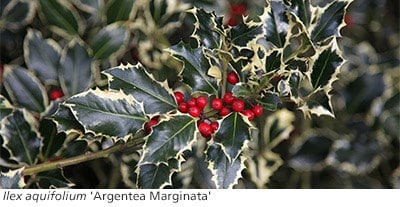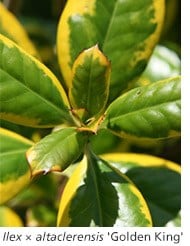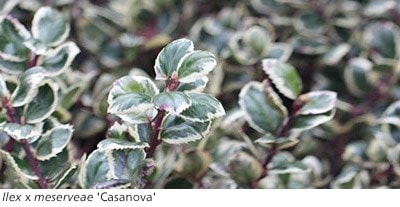The King of evergreens
The holly reigns supreme in winter, but there are decisions to be made. If you want berries you can’t close clip and topiarise because you’ll cut away the flowers. You have to allow your holly to flourish on its own, with just a yearly spring trim, in order to get those red winter jewels. You must also make sure that you plant a female variety because hollies are dioecious (meaning two houses), and male and female flowers appear on separate bushes - and it’s only the female bushes that produce berries. In built up areas there’s usually plenty of male pollen carried around by the bees to pollinate the females, but in remoter areas you will need to plant a male holly as well. One male though, will serve a whole harem of female hollies.
A holly by any other name?
 You can’t go by name, for some so-called Kings are indeed females and some so-called Queens are males masquerading as ladies by name only. There is an exception though. One green-leaved holly berries on its own because it's self-fertile - Ilex aquifolium‘J.C. van Tol’. However the berries cluster down the stems rather than in traditional clusters above the foliage. Most holly berries disappear once cold weather arrives, so if you want them for festivities pick them in early December and store them somewhere cool. Leave plenty for the birds though!
You can’t go by name, for some so-called Kings are indeed females and some so-called Queens are males masquerading as ladies by name only. There is an exception though. One green-leaved holly berries on its own because it's self-fertile - Ilex aquifolium‘J.C. van Tol’. However the berries cluster down the stems rather than in traditional clusters above the foliage. Most holly berries disappear once cold weather arrives, so if you want them for festivities pick them in early December and store them somewhere cool. Leave plenty for the birds though!
Hardy garden hollies come in three main types. The English holly (Ilex aquifolium) is sharp and prickly and therefore needs careful siting. It's masochism to plant this in a border that you have to weed by hand, or to put it close to walkways. Aquila is Latin for eagle - so think eagle talons as a reminder of how sharp those leaves really are. However English hollies make superb specimen plants in a lawn, or placed in strategic positions. Many of them from majestic shapes.

Most popular English hollies have some variegation which lights up the foliage. Ilex aquifolium 'Argentea Marginata' is an old 18th century variety known as the broad-leaved silver holly. The shiny green leaves, crisply margined in custard-cream yellow, set the clusters of red berries off. This clips really well, or it can be left to form a small tree and the new flush of spring growth will add a pink glow.
Highclere holly (Ilex x altaclerensis) is a natural hybrid between English holly and a tender large-leaved holly (I. perado) from The Azores. The two met when it became common to grow this large-leaved tender holly in orangeries in the 18th and 19th centuries. Bees carried pollen from these hothouse beauties to the wild hollies in the woods. The hybrid was first recorded and named at Highclere House in Berkshire by Loudon in 1838. Altaclerensis means the house of clere. The home of Downton was the first place this larger leaved holly was found, but it was soon discovered in many other places too.
 One of the most highly regarded is Ilex x altaclerensis ‘Golden King’. This is a female berrier, despite its manly name, with rounded dark green leaves shaded in grey and then edged randomly in bright creamy yellow. Like all Highclere hollies, it’s faster growing than English holly and can be topiarised into standard mop heads, or it can be used to form a hedge. It’s also good left to its own devices and, however you use it, it creates its own bolt of winter sunshine.
One of the most highly regarded is Ilex x altaclerensis ‘Golden King’. This is a female berrier, despite its manly name, with rounded dark green leaves shaded in grey and then edged randomly in bright creamy yellow. Like all Highclere hollies, it’s faster growing than English holly and can be topiarised into standard mop heads, or it can be used to form a hedge. It’s also good left to its own devices and, however you use it, it creates its own bolt of winter sunshine.
New York or Blue hollies (Ilex x merserveae) are also hybrids between English holly, this time with I. rugosa, a dwarf holly from the Far East. This deliberate cross was made by an American gardener called Katherine Meserve in the 1950s. Her Long Island home was beset by cold winters and she set about breeding a holly that could withstand North Eastern America’s severe weather and she succeeded. These hollies have a blue tint to their foliage and purple stems so in winter light they can look almost black, but they are extremely hardy. The female ‘Blue Angel’ berries up, but is slow-growing, which makes it ideal for a small garden - but not for a hedge!

There’s a new variegated male form, Ilex × meserveae 'Casanova', which has rounded grey-green leaves widely margined in silver-white which is in turn flecked with bright-pink. This makes an excellent container plant, or a small specimen close to a doorway. It will also pollinate any female hollies nearby, regardless of type. In fact it thoroughly lives up to its promiscuous name of ‘Casanova’.







